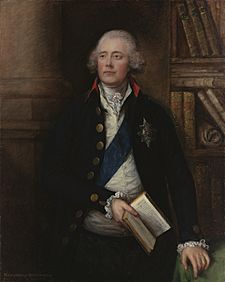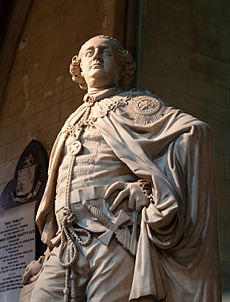George Nugent-Temple-Grenville, 1st Marquess of Buckingham facts for kids
Quick facts for kids
The Most Honourable
The Marquess of Buckingham
|
|
|---|---|

Portrait by Thomas Gainsborough
|
|
| Secretary of State for Foreign Affairs | |
| In office 19 December 1783 – 23 December 1783 |
|
| Monarch | George III |
| Prime Minister | William Pitt |
| Preceded by | Charles James Fox |
| Succeeded by | Marquess of Carmarthen |
| Lord Lieutenant of Ireland | |
| In office 27 October 1787 – 24 October 1789 |
|
| Monarch | George III |
| Prime Minister | William Pitt |
| Preceded by | The Duke of Rutland |
| Succeeded by | The Earl of Westmorland |
| In office 15 August 1782 – 3 May 1783 |
|
| Monarch | George III |
| Prime Minister | The Earl of Shelburne The Duke of Portland |
| Preceded by | The Duke of Portland |
| Succeeded by | The Earl of Northington |
| Member of Parliament for Buckinghamshire |
|
| In office 1774–1779 |
|
| Preceded by | Richard Lowndes |
| Succeeded by | Thomas Grenville |
| Personal details | |
| Born |
George Grenville
17 June 1753 |
| Died | 11 February 1813 (aged 59) Stowe, Buckinghamshire, England |
| Resting place | Wotton Underwood, Buckinghamshire, England |
| Spouse |
Hon. Mary Nugent
(m. 1775; died 1812) |
| Children |
|
| Parents |
|
| Relatives |
|
| Alma mater | |
| Occupation | Statesman |
George Nugent-Temple-Grenville, 1st Marquess of Buckingham (born 17 June 1753 – died 11 February 1813), was an important British politician. Before 1779, he was known as George Grenville. From 1779 to 1784, people called him The Earl Temple.
Contents
Early Life and Family Connections
George Grenville was the oldest son of George Grenville, who was once the Prime Minister of Great Britain. His mother was Elizabeth Wyndham. George had many important family members. His uncle was Richard Grenville-Temple, 2nd Earl Temple. His younger brothers were Thomas Grenville and William Grenville, who also became a Prime Minister.
In 1764, when George was 11, he got a job called a Teller of the Exchequer. This was a financial role in the government. He went to Eton College from 1764 to 1770. After that, he studied at Christ Church, Oxford in 1770. In 1774, he went on a "Grand Tour." This was a long trip through Italy and Austria, common for young wealthy men to finish their education.
In 1775, George married Mary Nugent. Her father was Robert Nugent, 1st Earl Nugent. The next year, Mary's father was given the title Earl Nugent. This title was set up so that if he didn't have any sons, it would pass to his new son-in-law, George.
Political Beginnings and Rise
In 1774, George Grenville was elected as a Member of Parliament (MP) for Buckinghamshire. An MP is a person elected to represent a group of people in the House of Commons, where laws are made. In Parliament, he strongly disagreed with the government's policies regarding America.
In September 1779, George's uncle died. This meant George inherited his uncle's title and became the 3rd Earl Temple. With this new title, he moved from the House of Commons to the House of Lords. The House of Lords is another part of the British Parliament, usually for people with inherited titles or special appointments.
Around this time, he also added the family names Nugent and Temple to his name. So, his full family name became Nugent-Temple-Grenville.
Lord Lieutenant of Ireland
In 1782, Lord Temple was chosen to be the Lord Lieutenant of Buckinghamshire. This meant he was the King's representative in that county. In July 1782, he became a member of the Privy Council. This group advises the King. He was also appointed Lord Lieutenant of Ireland. This was a very important job, as he was the King's main representative in Ireland.
During his time in Ireland, he helped pass the Renunciation Act of 1783. This law helped Ireland gain more control over its own laws. As Lord Lieutenant, he also created the Order of St Patrick in February 1783. This is a special order of knighthood, and he became its first leader.
He left Ireland in 1783 and focused on politics in England. He had the trust of King George III. He spoke out against a new law called Fox's East India Bill. The King even sent a message through him, saying that anyone who voted for the bill would be seen as an "enemy." This message helped defeat the bill.
In December 1783, he became a Secretary of State when Pitt the Younger became Prime Minister. However, he resigned just three days later. This was one of the shortest times anyone has held a cabinet job in British history.
Marquess of Buckingham
In December 1784, Lord Temple was given an even higher title: Marquess of Buckingham.
In November 1787, he was again appointed Lord Lieutenant of Ireland. This second time was not as successful. Some people criticized him for spending too much money. The Irish Parliament also disagreed with him when he refused to send a message to England asking the Prince of Wales to become regent (a temporary ruler). He had to use a lot of bribery to keep his position.
When his father-in-law died in 1788, Buckingham also became the 2nd Earl Nugent. But because he already had the higher title of Marquess, he was still known as the Marquess of Buckingham. His wife, Mary, later became Baroness Nugent in 1800. She passed this title to their second son. Because he was not very popular, he resigned his job in Ireland in September 1789.
Later Life and Legacy
After his time in Ireland, the Marquess of Buckingham was not very involved in politics. However, he did support the Act of Union of 1800. This law joined Great Britain and Ireland into one country, the United Kingdom.
His wife, Mary, died in 1812. George Nugent-Temple-Grenville himself died on 11 February 1813 at his home, Stowe, in Buckinghamshire. He was buried at his family home, Wotton.
He had two sons:
- Richard, Earl Temple, who became the 2nd Marquess of Buckingham. He later became the Duke of Buckingham and Chandos.
- George, who became the 2nd Baron Nugent after his mother died.
See also
- Grenvillite


